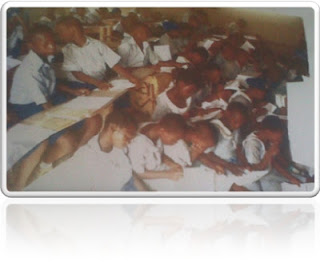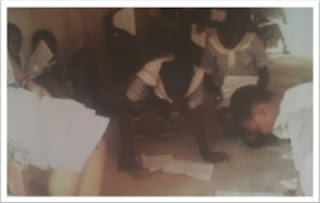Few months ago, there was a
revelation on Ajuwon High school where students writing exams were made to sit
on tyres, dusty floors. Argument on who is responsible shifted back and forth
with chunk of it falling on the state governor, Ibikunle Amosu, for failing in
his election promises.
A similar scene greets my visit
recently when I made a call to Igbobi Junior High school, Yaba. Unlike the case
of Ajuwon high school, something remarkable that each and every one of us can
learn from happened.
Igbobi Junior High School, located on the border axis
of the old western region of Lagos now falls under Somolu Local Government was
established in 1982, during the short-lived second republic under Jakande’s
administration as Igbobi Girls High School (an all girls’ school). Until
recently when Governor Babatunde Fashola’s administration face-lifted the
school structure with modern edifice, a poultry-like structure has been the
school standard classrooms.
Until few years ago when government placed a
moratorium on students providing furniture by themselves, pupils in this school
had better days.
 |
| New face of Igbobi Junior High School |
 |
| Another class after six months of furious battle with powers to be |
The school comprised of about 2000 students as at
November 2012 with total furniture capable of handling less than 10% of these
students.
From the main road leading to the school, a new
three storey building structure covered the landscape. To an unsuspecting
visitor, the students are being treated to the best of infrastructures
available. With words of mouth, I cannot describe what greeted my eyes when I
visited the school.
I will never have agreed with anyone saying such
a situation is possible in Lagos if I didn’t see it with my own eyes.
During lecture hours, these young boys and girls hang
on weak wall, sit on makeshift stools or simply sit on heap of dust they
gathered as makeshift seat.
From 8:00am when lecture starts till 2:00pm when the
school close shop, these young pupils between the ages of 10-14 years endured
unimaginable conditions in the name of learning.
July 2012, when the matter attained a torrid
point, an emergency parent/teacher meeting was called on how to tackle the
issue. At the end of a tempered debate, majority of the parents decided to
contribute and put the needed furniture in place.
The vice-principal of the school, M.A. Adelugba (Mr.),
slim in stature, ripe in age and management experience rejected the resolution.
With a hard time keeping up with the rate at which I
rapped my questions, he explained how he began a journey of letters to Special
Adviser to Education (MoEdc.), State Universal Education Board (SEPEB),
Ministry of Education and other agency in charge of education inn Lagos.
The letter, which was addressed to the Permanent
Secretary of the Lagos State ministry of Education, Alausa through the Tutor
General, Education District II, Maryland (SUPEB), described the decrepitude
state of furniture in relation to the students’ population in the school.
A line in the letter reads:
“The school cannot boast of 180 dual desks and benches. The present
situation is a pitiable site (sight) to behold with most of the students
population sitting on bare floor in (all) classrooms for lectures, class tests
and state unified examinations.”
For Mr. Adelugba, it was a rough, uninspiring journey
that took months, his action started a renaissance of what now defines the face
of the school furniture. Had it not been for tenacity and experience, this
journey might as well end in the same box like the Ajuwon High School story
where the final blame went as high as the state governor who resides in
Abeokuta.
The moment we see the government in the 'little'
position we occupy, that is the defining moment when we are back on track to a
better Nigeria.
- Don Abiodun Odedeyi



.jpg)


No comments:
Post a Comment